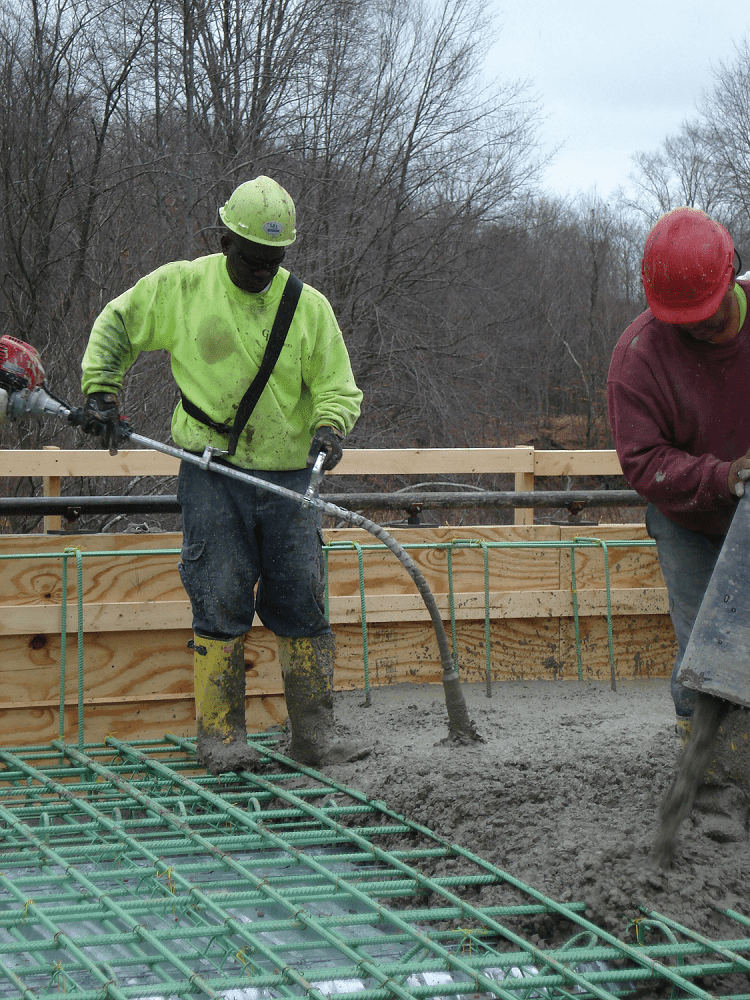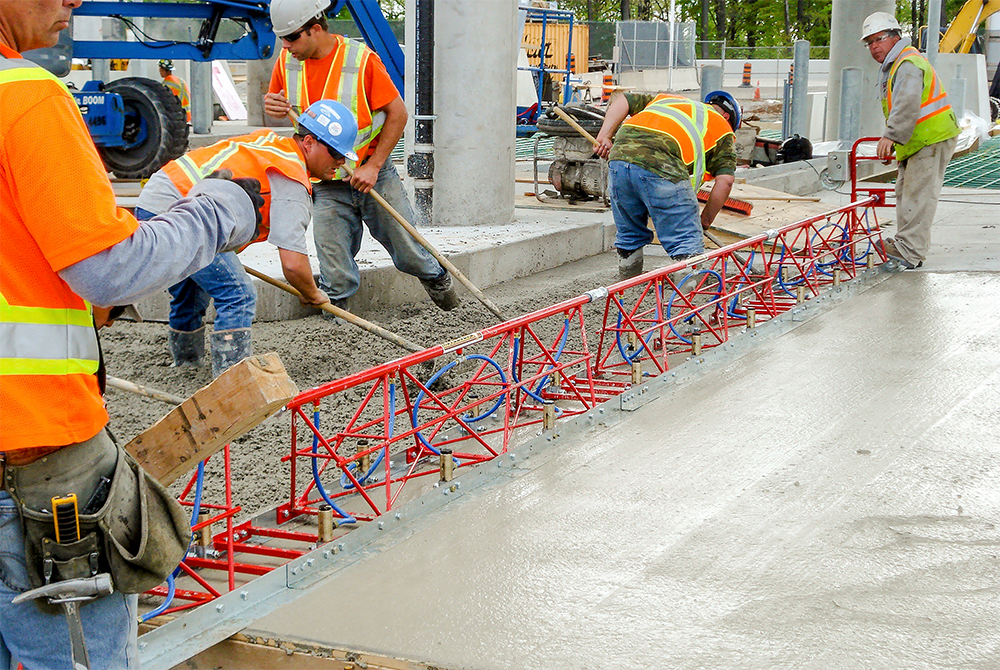West Coast General Engineering commercial concrete: The Complete Guide to Performance in Commercial Construction
The Essential Function of Concrete Structure in Structural Stability and Long Life
When it concerns constructing a building, the foundation is extra crucial than you may think. Concrete structures offer unparalleled strength and toughness, guaranteeing your framework can withstand different ecological obstacles. Without a solid base, you take the chance of potential problems like changing or fracturing, which can endanger safety and security and worth. Recognizing the subtleties of concrete foundations might be the key to preserving your financial investment for years to come. What should you consider next?
Recognizing the Importance of Concrete Foundations
Concrete foundations are vital to the total stability of any type of framework, as they give the important support needed to endure various loads and environmental conditions. When you think about building a home or a commercial space, the foundation is the initial point you need to take into consideration. It works as an obstacle versus wetness, safeguarding your building from water damage. A well-placed concrete foundation also prevents settling and changing, which can bring about cracks in wall surfaces and floorings. You'll intend to ensure that the foundation is correctly developed and reinforced, as this influences the long life of your building. Additionally, a solid structure can improve energy performance by lowering air leakages. Keep in mind, ignoring the value of a concrete foundation can bring about costly fixings down the line. So, purchasing a high quality structure upfront is vital for the integrity and toughness of your structure.
Benefits of Concrete Structures for Structural Integrity
While lots of elements add to a building's architectural stability, concrete structures provide unmatched toughness and strength. You'll value that concrete can withstand severe climate condition, resisting both wetness and temperature level variations. This resilience indicates your structure is less likely to experience splitting or changing gradually, which can compromise its safety.Additionally, concrete's intrinsic weight gives a solid base, protecting against motion throughout natural events like quakes or floods. When you select a concrete structure, you're also choosing for low upkeep; unlike timber, it won't rot or draw in parasites, saving you money and time in repairs.Moreover, concrete's fire resistance uses included safety, ensuring your framework can sustain high temperatures without significant damage. Generally, purchasing a concrete foundation means you're prioritizing the long-lasting security and honesty of your structure, making it a sensible choice for any building task.
Common Kinds Of Concrete Foundations
When it comes to developing foundations, recognizing the usual kinds of concrete structures can aid you make educated choices for your project. The most prevalent kinds consist of slab-on-grade, crawl room, and complete basement foundations.A slab-on-grade structure is an easy, economical choice, where a thick concrete piece is put directly on the ground. This type works well in warm climates, as it minimizes heat loss.Crawl space structures boost the home a little over ground, enabling air flow and access to plumbing and electrical systems. This layout can aid protect against dampness issues.Full cellar foundations provide additional living or storage room while giving excellent architectural assistance. They need more excavation and are usually utilized in colder environments to protect against frost heave.
Variables to Think About When Designing a Concrete Structure

Finest Practices for Setting Up Concrete Foundations
When you're installing a concrete foundation, correct website preparation is necessary to ensure stability (West Coast General Engineering industrial concrete). You'll likewise need to comprehend support methods to enhance toughness and toughness. Finally, do not neglect the healing process, as it plays a basic function in achieving a solid structure
Website Preparation Relevance
It might seem straightforward, appropriate site preparation is important for ensuring a solid and long lasting concrete structure. Begin by getting rid of the location of any kind of particles, greenery, or natural material that could compromise the structure's stability. Next off, analyze the dirt kind and compaction; you might require to excavate or add materials to develop a stable base. Degree the ground to guarantee also weight distribution and stay clear of settling issues in the future. Installing correct drain systems is likewise crucial to protect against water buildup, which can damage the structure gradually. Lastly, mark out the structure's dimensions precisely to direct the pouring procedure. By following these actions, you'll set the stage for an effective concrete foundation that stands the test of time.
Support Methods Discussed
As soon as the website is correctly prepared, the following action in guaranteeing a sturdy concrete structure involves executing efficient support methods. You ought to begin by utilizing steel rebar, which provides tensile toughness and assists protect against splitting. Lay the rebar in a grid pattern, ensuring it rises making use of spacers to preserve proper coverage. In addition, think about using cable mesh for extra support, specifically in areas based on heavy tons. Don't fail to remember to link the rebar crossways firmly with wire. For bigger foundations, fiber reinforcement can boost sturdiness, reducing the danger of contraction fractures. Constantly follow regional West Coast General Engineering commercial concrete building ordinance and guidelines to ensure conformity. By applying these support techniques, you'll considerably boost your foundation's stamina and long life, laying a solid groundwork for your framework.
Curing Process Fundamentals
To assure your concrete foundation cures appropriately, it is very important to maintain appropriate dampness and temperature conditions right away after putting. Beginning by covering the surface with a wet burlap or plastic sheet to maintain dampness. This keeps the concrete hydrated, avoiding fractures and making certain toughness. You should also keep track of the temperature level; excellent curing conditions are between 50 ° F and 90 ° F. If it's too hot, mist the surface on a regular basis to avoid quick dissipation. For cool climate, take into consideration using insulating blankets to maintain warmth. Go for a curing duration of at the very least seven days, as this is crucial for optimal strength growth. By adhering to these ideal methods, you'll boost your structure's longevity and long life, making certain architectural stability for years to come.
Upkeep of Concrete Structures for Durability
To keep your concrete foundation solid and enduring, routine evaluations are essential. You ought to likewise ensure reliable water drainage remedies are in place to avoid water damage. If you identify any splits, resolving them quickly will conserve you from larger problems down the line.

Routine Examinations and Analyses
While routine assessments and analyses could appear like a chore, they're necessary for maintaining the integrity of your concrete structure. By regularly looking for cracks, shifts, or signs of wear, you can catch potential issues before they escalate into costly repairs. Search for any water pooling around the structure or unusual settling, as these can indicate underlying troubles. It's also important to monitor any type of adjustments in your home's structure, like doors that stick or windows that don't open efficiently. Maintaining a document of your assessments assists track changes in time, permitting for proactive maintenance. Eventually, these analyses guarantee your foundation stays steady, supporting the longevity and safety and security of your whole structure. Don't forget this crucial element of homeownership!
Reliable Water Drainage Solutions
Normal inspections can expose problems like water drainage troubles that could compromise your concrete structure's stability. To avoid water buildup, ensure your gutters and downspouts direct water far from the structure. Installing French drains pipes can successfully reroute surface area and groundwater, lowering stress on your structure wall surfaces. In addition, grading the dirt around your home helps assure that water flows away, instead of pooling near your foundation.Consider utilizing sump pumps in locations susceptible to flooding, as they actively eliminate excess water. On a regular basis look for blockages in drain systems and clear them immediately. You'll secure your foundation's stability and longevity by taking these positive actions. Keep in mind, reliable drainage solutions are important for maintaining a solid, sturdy concrete structure.
Prompt Fracture Services
When you discover fractures in your concrete foundation, resolving them promptly is vital for keeping its longevity. Little splits can quickly develop right into bigger issues, jeopardizing the architectural honesty of your home. Routinely check your structure for signs of damage, such as horizontal or upright splits. If you detect any, don't wait-- fix them promptly. You can utilize epoxy shots or concrete patching substances, which work for securing splits. Always follow the producer's directions and think about getting in touch with a specialist for significant damage. Remember, timely repairs not only enhance your structure's resilience yet likewise save you money over time by stopping a lot more substantial repair services down the line. Remain positive, and your structure will remain strong and protected.
Dealing With Common Issues With Concrete Foundations
Concrete structures can encounter numerous concerns gradually, making it important to determine and address them promptly. Among one of the most usual troubles is splitting, which can happen due to temperature variations or clearing up soil. If you notice splits, it's vital to analyze their size and depth; tiny fractures can frequently be sealed, while bigger ones may call for expert evaluation.Water intrusion is an additional significant issue. Excess dampness can cause mold development and architectural damage. Assurance proper water drainage around your foundation to minimize this danger. Additionally, try to find signs of changing or bowing walls, as this can show underlying problems with your structure's stability.Regular evaluations are basic to catch these troubles early. If you find any kind of concerning indicators, don't think twice to speak with a structure expert. By remaining aggressive, you can preserve the honesty and longevity of your concrete structure, guaranteeing your home stays secure and protected.
Often Asked Questions
Exactly How Does Dirt Kind Affect Concrete Structure Efficiency?
Soil type considerably affects concrete foundation efficiency. If you have actually got extensive clay, for example, it can cause shifting and splitting. Sandy dirt might result in clearing up. Understanding your soil assists ensure a secure foundation.
Can Concrete Foundations Be Repaired if Damaged?
Yes, you can fix broken concrete structures. Depending on the extent of the damage, methods like epoxy shot or piece jacking can recover security. It's best to speak with an expert for reliable remedies.
What Is the Regular Lifespan of a Concrete Foundation?
A concrete foundation usually lasts 30 to 100 years, depending upon aspects like dirt problems, environment, and upkeep. You'll intend to watch on it to assure it continues to be healthy throughout its life-span.
Exist Choice Products to Concrete for Foundations?
Yes, there are alternatives to concrete for foundations, like steel, timber, and even recycled materials. Each alternative has unique advantages and downsides, so you need to consider your task's specific demands when picking the appropriate product.
Exactly How Does Climate Effect Concrete Foundation Resilience?
Climate greatly influences concrete structure toughness (West Coast General Engineering Concrete). Severe temperatures, moisture, and freeze-thaw cycles can damage the material, bring about fractures and structural concerns. You must consider neighborhood climate problems when preparing your foundation to ensure long-term efficiency